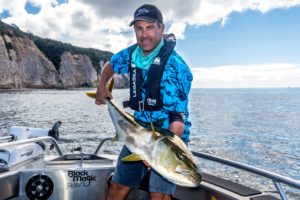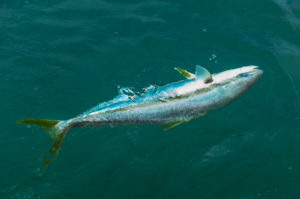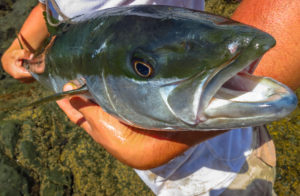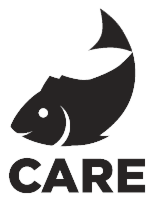
Yellowtail kingfish are a highly respected sportfish and New Zealand has arguably the best kingfish fishery in the world. Out of the 37 IGFA claimed world records for Southern yellowtail, currently 35 have been captured in New Zealand and two captured in Australia.
This world class fishery makes them a popular sport fish for Kiwis as well as charter operators, some of whom target them exclusively for local and international clients. The economic and social value of kingfish to New Zealand fishers, visitors and regional economies is high. As such, it is in our best interests to understand and adopt best practice principles when catching and releasing kingfish.
Techniques
Lures, live baits and well-presented dead baits are the most popular techniques employed to target kingfish. Fishers need to respect this powerful fish and use suitably heavy tackle as they have a well-known reputation for breaking gear, cutting lines on underwater obstacles and quickly escaping.
While leaving fishers in a state of awe when this happens, it can sadly lead to the kingfish’s demise. Carrying terminal tackle around will impede their ability to feed and could hinder the evasion of predators. A good choice is 24kg-37kg mainline as lighter line may result in longer fight times, reducing the chances of survival due to a shark attack. There are some exceptions such as fly fishers sight fishing for smaller specimens in clear, shallow water. The minimum legal size for a kingfish is 75cm, which is about a 6kg fish.

Hot tips –
- Tie strong and reliable knots.
- Make sure your reel and rod are fit for purpose and well maintained so the possibility of gear failure is minimised.
- Lures (i.e. knife jigs or top water lures) usually hook fish in the jaw and these fish have a better chance of survival than fish hooked deep.
- When lure fishing with stick-baits or trolling lures like Rapalas, please replace treble hooks with single inline hooks. Treble hooks are more likely to catch a fish in the throat area if taken down and do fatal damage to the gill filaments. Treble hooks can also damage the fish’s eyes or catch under the throat and cause excessive bleeding, plus are potentially dangerous for the angler when removing the hooks from lively fish.

- When using live baits to target kingfish, use non-offset circle hooks as these have been proven to reduce gut hooking and the risk of mortality
- Use suitably strong leaders to reduce the risk of breakage and help control the fish when landing.
- If using sinkers whilst live baiting always position the sinker above the swivel (and the hook below the swivel) so that if they do break the line they do not have to tow around the sinker.
Handling and Release Techniques
Kingfish are a species that can handle being caught and released fairly well as they are not susceptible to barotrauma, and if handled properly will recover fairly quickly. On the north east coast one Coromandel charter operator reported the same fish being captured and released three times in one week. While highly unusual, it shows that with careful handling kingfish can successfully recover from capture and release. Ideally, where possible, release fish whilst still in the water boat side.
Safely Landing Fish Intended For Release
- At every stage of handling, take good care of the fish so its chances of survival are maximised if the fish is to released.
- If you need to bring a kingfish on board for tagging, measuring or a quick photo, use a rubber mesh net for smaller fish.
- When landing larger fish there are several options. If your boat is close to the water and the fish is caught on a jig you can lift it by holding the jig.
- On larger boats where you may be further from sea level and the fish is too large to net or bring aboard by hand, you can use a lip gaff or a lip-grip device designed to lock on the lower jaw.
- File or flatten the barbs on your hooks so they are easy to remove. This reduces excessive handling or damage to the fish.
- When removing lures with more than one hook, be extra careful as a thrashing fish can be extremely dangerous, easily swinging the ‘free’ hook into exposed flesh.
- Do not under any circumstances put your hands in the gills or gaff the fish anywhere other than the mouth.
- If the fish has been caught on a bait and you cannot see the hook in the fish’s mouth, do not use the trace to lift the fish aboard. Cut the line as close to the mouth as possible whilst the fish is in the water or use a net or lip gaff if the fish must be bought aboard.
- Large kingfish have learnt how to survive over time and these genes are valuable for the population. Please consider releasing large fish instead of killing them.

Measuring and Photographing
- Place any fish on cool wet surfaces. Fish dislike being placed on hard surfaces, so you may need to gently restrain the fish in order to measure them.
- Do your best to stop them from thrashing around on the floor.
- Do not drop them from a height.
- On the measuring board you can hold one hand over their head and the other around the base of the tail. If a photograph is required, have someone on the opposite side of the measuring board ready to photograph them (so you do not obscure the fish and the board).
- Cradling the fish by mid-section with both arms so the weight of the fish is supported is good practice. This is a good way to hold them when taking photos of angler and fish.
- Do not use a towel on the fish, the possible exception being a small, soft, clean wet cloth placed over the fish’s eyes to help calm it.
- Before bringing the kingfish onboard, have all the necessary items (measuring board, tags, camera etc) ready and quickly accessible so that the time the fish is out of the water is kept to a minimum.
- Keep your hands out of the gills at all times.
- When lifting the fish for release you can safely hold one hand around the base of the tail and the other holding the lower jaw. For a more secure release just hug the fish with one arm while holding the base of the tail in the other hand.
- On release, slide the kingfish into the water head-first.

Accurate measuring
The point of using a measuring board is to get an accurate length measurement. To achieve this the fish must have its lower jaw against the headboard of the measuring device. If you have a photograph of the fish you can then read the length at the fork of the tail. If not, you will need to record the length before releasing the fish, either on the tag card or your catch sheet. The correct measurement is the nearest centimetre down from the tail fork. In other words, if the fork is exactly on 87 cm, that is the correct length to record. If it is between 87 cm and 88 cm, then record 87 cm as the length. This is standard scientific practice.

Tagging
Tagging kingfish is a great practice as it can help with gathering data and contribute to better management of the species. If you intend to tag the kingfish, place the tag on the upper dorsal surface below or just behind the dorsal fin, angled towards the back to improve water flow over the tag. Tags that have been correctly implanted can stay attached for many years and provide excellent information on growth rate for this species. Kingfish will try to rub off tags placed on the side of fish. These tags are often returned in a badly worn condition where no number remained and therefore the tagging had been greatly reduced in value. For more information on tagging kingfish, go to – www.fishtagnz.co.nz/yellowtail-kingfish-tagging-procedure/


